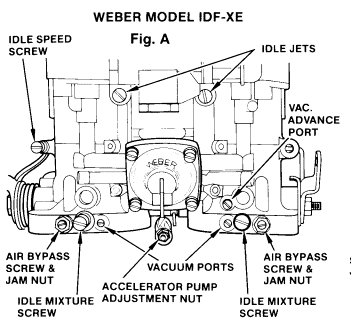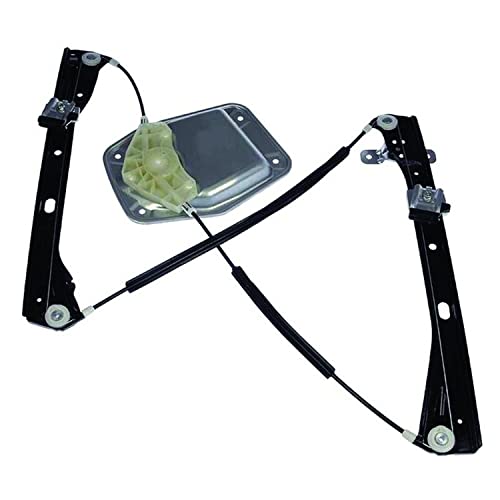Westy Richardson said:
I'm running 115 main, 50 idle, 190 air correctors F11 imulsion tubes and an 009 distributor. I know the bypass screws your on about, my old carbs had screws with lock nuts where as my current set has vac take-offs in their place which i've just blocked off using rubber caps. All the jets are the same as the sets from my old carbs, I'm thinking it may have a slight air leak somewhere in the system. It's the same set-up which i had before my old webers f***** up and before that happened the engine ran great :?
Thats odd - the bypass and the vac takeoff on each barrel are normally seperate and not interchangeable eg. they normally have screws for the bypass and the vac takeoff is a small tube with a tiny block off screw in the end.
Heres a borrowed diagram

On a 1600 the Venturi should be 28mm, main 1.30, main A/C 2.00, emulsion F11, idle .55, pilot .50
and some setting up instructions :-
It is most important to verify all linkage and levers are installed without binding and the linkage opens to full throttle and is allowed to close to the Idle Speed Screw. This is the number one and two reasons for tuning errors, improper linkage installations and over tightened linkage nut, causing binding in the linkage assembly.
The Individual Runner carbs, IDF, have individual Idle jets and mixture screws for each barrel. They also have an additional air bleed screws and lock nuts. This is not used for idle adjustment or idle quality. The settings for these screws should be closed.
Standard IDF Settings:
Speed screw ¼ to ½ turn in after contact with lever maximum.
Mixture Screw 1 turn out from lightly seated.
“Lean Best Idle†Procedures
After confirming the linkage allows the throttle lever to seat against the Idle Speed Screw. Back off the Idle Speed Screw, then turn the screw in until it contacts the throttle lever and turn it in ½ turn. Turn in the Mixture Screw in until it “LIGHTLY†seats, then back it out 1 full turn. Loosen the 8mm wrench size nuts on the “air bleed†screws, turn in the air screws until it seats then tighten the nut.
a. Start the engine, it will run slow and like a tractor. As long as it will stay running, the idle speed is not important at this point.
b. First, turn in the mixture screw until the engine runs worse, then back out the screw ¼ turn at a time. The engine should start to smooth out. Continue to back the screw out ¼ turn at a time until the screw does nothing or runs worse. Then turn it back in to the point where it ran best. You want to tune the engine by sound. Adjust each mixture screw to the best, fastest and smoothest running point. Do this procedure with each mixture screw.
c. Now you may adjust the Idle Speed Screw. It should be sensitive and only require ¼ turn in or out to achieve the idle speed you like.
d. These carbs are commonly used in pairs, this makes the synchronization important, be sure to bring the high flowing carb down to the low flow carb. Then bring them both up to “proper†Idle speed. The Idle Speed Screws are not opened more than ½ turn in.
e. After synchronizing multiple carbs, reconfirm steps b. c. & d.
“Simple Rules for Calibrationâ€
If your mixture screw is out more than one turn like 11/2 turns then your idle jet is too lean, go up one half size on the Idle jet.
If you mixture screw is not out one full turn, something like only 1/2 turn out from seated then your Idle jet is too rich, go down one half size on the idle jet.
This is all based on the important fact that your speed screws are not open more than ½ turn if they are then that is also an indication that you have a lean Idle circuit. You are cheating by opening the throttle plates and exposing additional progression holes in the transition.
More Tuning & Adjustment
1. Most Critical! Be sure for initial carburetor set up all air by-pass screws should be in closed position. These are not commonly used in standard carburetor adjustment.
2. Set the idle speed screw at ¼ to ½ turn in after contact with throttle lever. When doing multiple carburetors all linkage should be disconnected. All carbs should be bench adjusted to same setting.
3. Set the idle mixture screw to one turn out form lightly seated. When checking the seated position to make only light contact with seat, aggressive seating will damage needle and seat of carburetor,
Adjustment if possible should be to find smoothest idle with each mixture screw on all carburetors. Some prefer to do one barrel of each carburetor then come back and do the second barrel
4. Start engine as long as engine starts and runs do not turn up idle speed first.
5. After preliminary lean best setting of idle. Check carburetors for synchronization. Commonly done by checking lead or front barrel of each carburetor.
6. You will always want to bring high flow carburetor down to match the low flow carburetor. If this cannot be done you will need to recheck bench assembly for binding throttle in high flow carb. Once you have matched both carburetors you will need to set the idle to the desired idle speed setting. This will be done by adjusting both carbs up or down the same amount and re checking for synchronization.
7. Make one last check of lean best (smoothest running position) idle on all mixture screws one last time.
8. Best idle should end up with the mixture screws at or near one turn off seat.
































